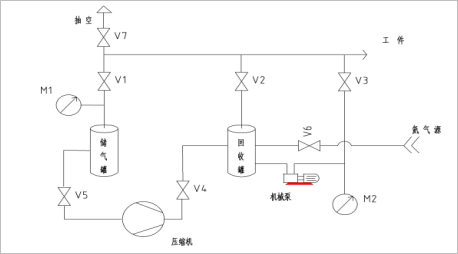Why Helium?
Helium is the best choice of tracer gas to find leaks for a number of reasons. It is non-toxic, inert,non-condensable, non-flammable and not normally present in the atmosphere at more than trace amounts(5 ppm). Due to its small atomic size,helium passes easily through leaks. The only molecule smaller than Helium is Hydrogen which is not inert.It is also relatively inexpensive and is available in various size cylinders.
How does it work?
The usage of helium as tracing gas to find and quantify leaks requires an instrument able to detect its presence. The instrument is the mass spectrometer that transforms the measurement of the mass of a gas into an electric signal. To do this, the air that enters the spectrometer is ionized and guided into a curved tube immersed in a magnetic field. For a given value of the magnetic field only helium ions go through, while the others are destroyed. The electric current produced by the helium ions flow is measured to quantify the leak.
Test methods
Helium charged - vacuum test
The part is put into a chamber where vacuum is created. The part is then pressurized with helium and the helium leakage is measured through a mass spectrometer. The test is objective, since does not depend on the operator. Detectable leak range goes from 5.0 x 10-3 mbar*L/s to 5.0 x 10-8 mbar*L/s. This method is used in automatic systems to test components as evaporators, condensers, tubes, hoses, pipes, airbags, canisters, fuel tanks, thermostatic valves.

Helium charged - sniffer test
The part is pressurized with helium. The mass spectrometer is fitted with a sniffer probe that is moved over the areas of possible leak to detect its presence. The test can be performed manually (by operator) or automatically. The detectable leak range is between 5.0 x 10-3 mbar*L/s and 5.0 x 10-5 mbar*L/s. This test is used for parts that cannot be put inside a vacuum chamber (refrigerators, refrigerated food displays) or to locate a leak that has been detected by other methods, in order to allow for parts repair.
Helium spray - vacuum test
The part to be tested is directly connected to a mass spectrometer and put inside a chamber. Vacuum is created inside the part and the helium concentration in the chamber is raised to 100%. If a leakage is present, the molecules of helium migrate into the part and the leakage is measured by the spectrometer. The possible leak range to be detected is from 5.0 x 10-3 mbar*L/s to 5.0 x 10-8 mbar*L/s. This test is frequently used to check porosities in cast parts or for parts that operate under vacuum, as water pumps and brake pumps.
Bombing test
This method applies to parts that are supposed to be sealed, as implantable medical devices and bulbs. The component under test will be first exposed for an extended length of time (e.g. 10 minutes) to a high helium pressure (40-50 bar) in a “bombing” chamber. If the part is leaky, helium will be able to penetrate the device. Then the component will be placed in a vacuum chamber. The amount of helium that entered the device will be released in the vacuum chamber and measured by the mass spectrometer. This method is not able to detect small leaks. Usual leak range to be detected is from 5.0 x 10-2 mbar*L/s to 1.0 x 10-4 mbar*L/s.
Helium Recovery System
Helium is widely used as an excellent tracer gas in the leak detection process. However, its increased costs – and their negative impact on profit margins – are a huge concern in today’s production environments.
Synergetic has developed a proven concept to recover helium for low-, mid- and high-pressure applications. The permanent system control visualizes the values and ensures that the ratio of helium to nitrogen remains constant throughout the testing process, eliminating contamination of the surrounding production area.
Benefits
· Collects up to 90%-98% of the tracer gas
· Keeps emissions at the workplace very low
· Remarkable economic savings
